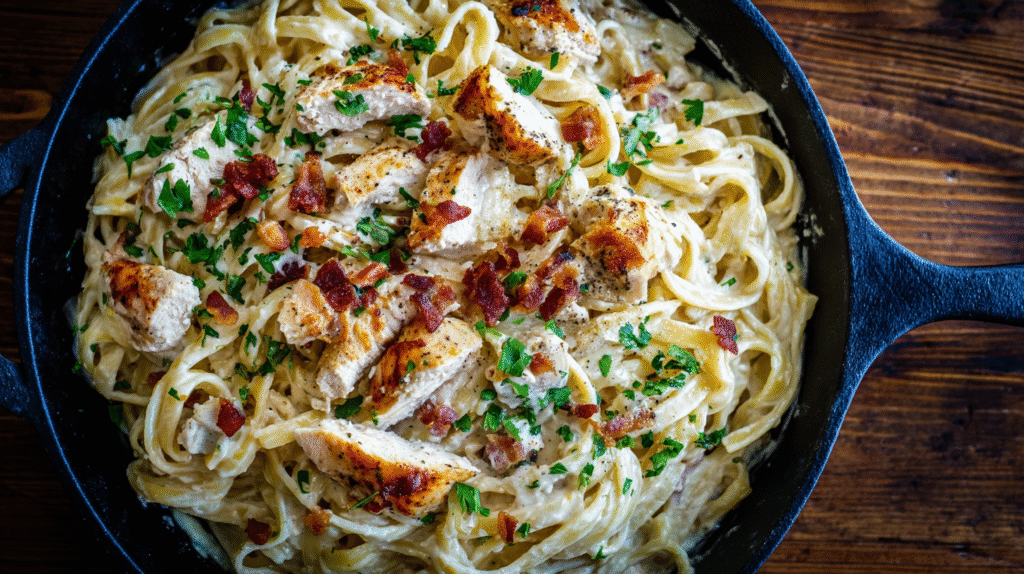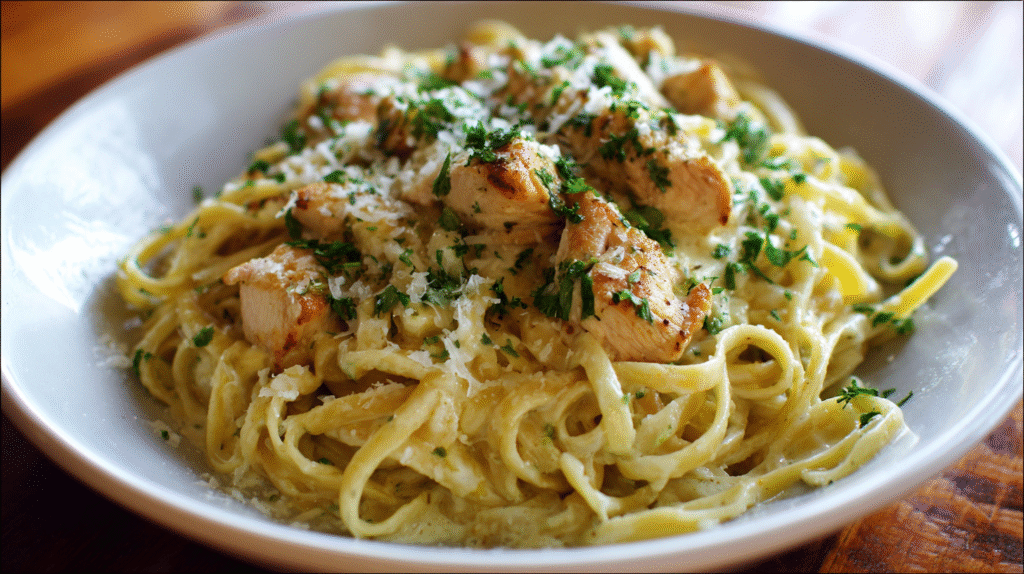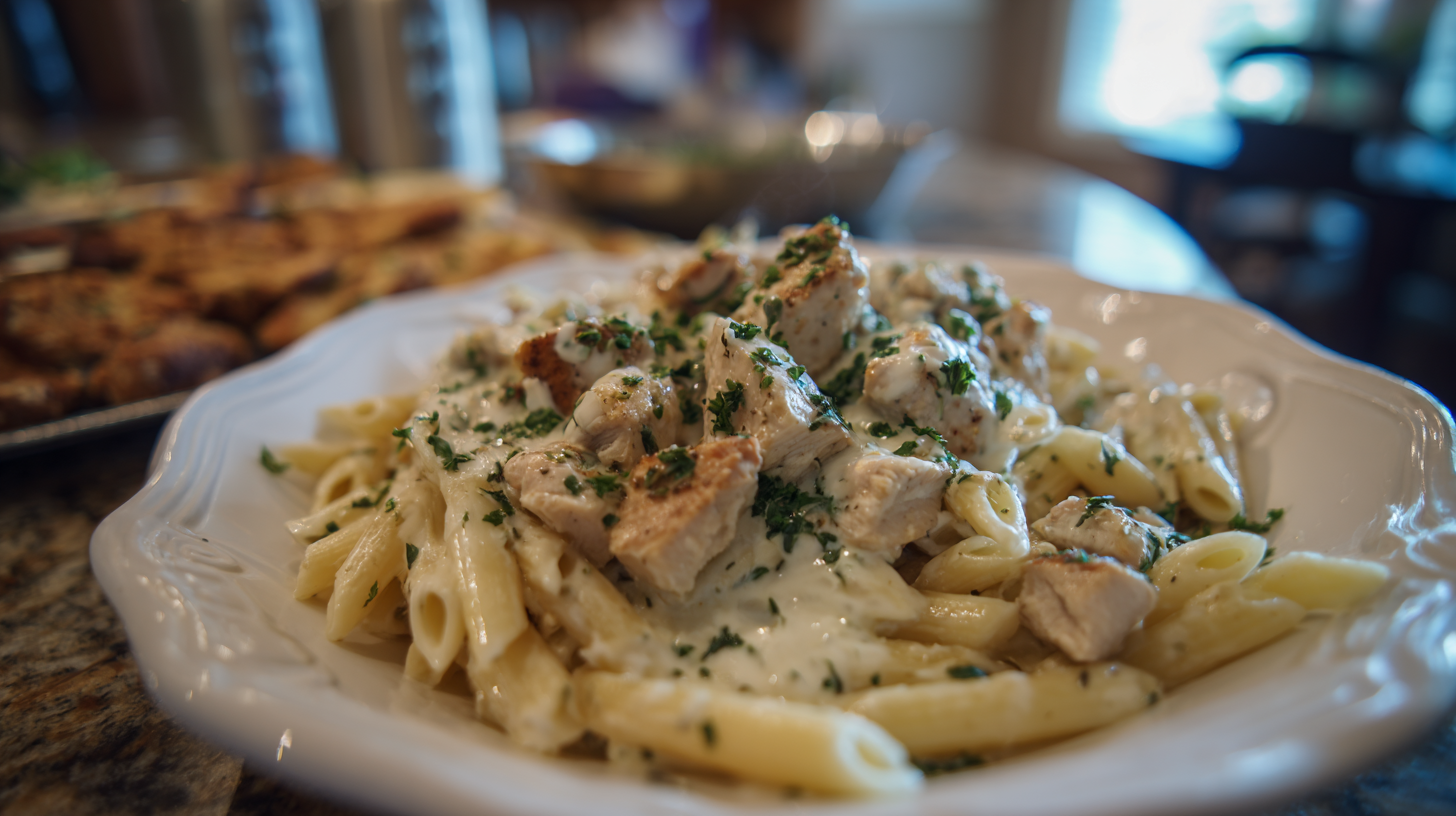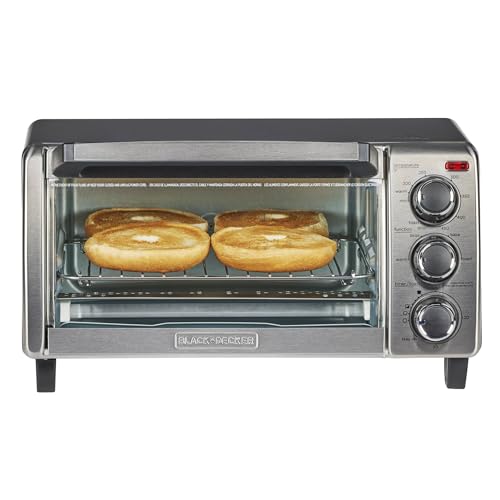Ingredients
This chicken alfredo recipe requires simple yet high-quality ingredients that work together to create restaurant-quality results. You’ll need ingredients for three main components: seasoned chicken breast, creamy alfredo sauce, and serving preparations.
For the Chicken
- 1 pound boneless skinless chicken breasts, pounded to even thickness
- 2 tablespoons olive oil
- 1 teaspoon garlic powder
- 1 teaspoon Italian seasoning
- 1/2 teaspoon salt
- 1/4 teaspoon black pepper
- 1/4 teaspoon paprika
For the Alfredo Sauce
- 4 tablespoons unsalted butter
- 4 cloves fresh garlic, minced
- 1 cup heavy cream
- 1 cup freshly grated Parmesan cheese
- 1/2 teaspoon salt
- 1/4 teaspoon white pepper
- 1/4 teaspoon nutmeg (optional)
- 2 tablespoons fresh parsley, chopped
For Serving
- 12 ounces fettuccine pasta
- Additional Parmesan cheese for garnish
- Fresh cracked black pepper
- Extra chopped parsley for garnish
Equipment Needed

Creating restaurant-quality chicken alfredo requires the right kitchen tools to achieve perfect results. You’ll need a large skillet or sauté pan to properly sear the chicken and develop those golden-brown flavors that make this dish exceptional.
A heavy-bottomed saucepan becomes essential for crafting the creamy alfredo sauce without scorching. The thick base distributes heat evenly and prevents the dairy from breaking or curdling during the cooking process.
Your pasta preparation demands a large pot that can accommodate the fettuccine with plenty of room for movement. This prevents the noodles from sticking together and ensures even cooking throughout.
A reliable colander makes draining the pasta quick and efficient while preserving the perfect al dente texture. You’ll also want a wooden spoon or silicone spatula for stirring the alfredo sauce as it thickens.
Sharp kitchen knives prove crucial for slicing the chicken breast into even pieces and mincing fresh garlic. Consistent cuts ensure uniform cooking and professional presentation.
Measuring cups and spoons help you achieve the precise ratios that create the signature creamy consistency. Digital kitchen scales offer even greater accuracy for ingredients like Parmesan cheese.
A microplane grater delivers the finest Parmesan shavings that melt seamlessly into your sauce. Freshly grated cheese creates a smoother texture compared to pre-shredded varieties.
Tongs provide excellent control when flipping chicken pieces and tossing the finished pasta with sauce. This versatile tool prevents damage to delicate ingredients while ensuring thorough coating.
Finally, serving bowls or plates warmed in a low oven keep your chicken alfredo at the optimal temperature for your guests to enjoy every creamy bite.
Instructions

Follow these step-by-step instructions to create restaurant-quality chicken alfredo in your own kitchen. Each stage builds upon the previous one to ensure perfect timing and optimal results.
Prep the Chicken
Pat the chicken breasts completely dry with paper towels. Place each breast between plastic wrap or parchment paper and pound to an even ¾-inch thickness using a meat mallet or rolling pin. Season both sides generously with salt and black pepper. Sprinkle garlic powder, Italian seasoning, and paprika evenly across the surface, pressing the spices gently into the meat. Set the seasoned chicken aside on a clean plate while you prepare the other components.
Cook the Pasta
Bring a large pot of salted water to a rolling boil over high heat. Add the fettuccine noodles and cook according to package directions until al dente, typically 8-10 minutes. Reserve ½ cup of the starchy pasta cooking water before draining. Drain the pasta in your colander and return it to the pot. Toss with a small amount of olive oil to prevent sticking and cover to keep warm.
Make the Alfredo Sauce
Melt the unsalted butter in your heavy-bottomed saucepan over medium-low heat. Add the minced fresh garlic and sauté for 30-45 seconds until fragrant but not browned. Pour in the heavy cream slowly while whisking constantly. Bring the mixture to a gentle simmer and cook for 2-3 minutes until it begins to thicken slightly. Remove the pan from heat and gradually whisk in the freshly grated Parmesan cheese until completely melted and smooth. Season with salt, white pepper, and a pinch of nutmeg if desired.
Cook the Chicken
Heat the olive oil in your large skillet over medium-high heat until it shimmers. Carefully place the seasoned chicken breasts in the hot oil without overcrowding the pan. Sear for 6-7 minutes on the first side without moving them, allowing a golden crust to form. Flip the chicken and continue cooking for 5-6 minutes more until the internal temperature reaches 165°F. Transfer the cooked chicken to a cutting board and let it rest for 5 minutes before slicing into ½-inch strips.
Combine Everything
Add the cooked fettuccine to the warm alfredo sauce and toss gently to coat every strand. If the sauce appears too thick, gradually add the reserved pasta water one tablespoon at a time until you achieve the desired consistency. Arrange the sliced chicken over the pasta in your warmed serving bowls. Garnish with freshly chopped parsley, additional grated Parmesan cheese, and freshly cracked black pepper before serving immediately.
Serving Suggestions

Your creamy chicken alfredo transforms into an elegant dining experience with thoughtful presentation and complementary sides. Serve this rich pasta dish immediately while the sauce maintains its silky texture and the chicken stays tender.
Bread Pairings
Warm garlic bread provides the perfect vehicle for savoring every drop of alfredo sauce. Crispy breadsticks offer a delightful textural contrast to the creamy pasta. Fresh Italian bread with herb butter creates an authentic restaurant atmosphere at your dinner table.
Vegetable Accompaniments
Steamed broccoli florets add vibrant color and nutritional balance to your plate. Roasted asparagus spears complement the rich flavors without overwhelming the dish. Caesar salad provides a crisp refreshing counterpoint to the creamy pasta.
Wine Selections
Chardonnay pairs beautifully with the buttery alfredo sauce and enhances the garlic notes. Pinot Grigio offers a lighter option that cleanses the palate between bites. Sauvignon Blanc provides crisp acidity that cuts through the richness of the cream sauce.
Presentation Tips
Warm your serving bowls in a 200°F oven for 5 minutes before plating to maintain optimal temperature. Twirl the fettuccine using tongs to create attractive nests on each plate. Arrange chicken slices in an overlapping pattern across the pasta for visual appeal.
Portion Guidelines
| Serving Size | Pasta Amount | Chicken Per Person | Sauce Coverage |
|---|---|---|---|
| Regular | 4-6 oz | 4-5 oz | 1/2 cup |
| Large | 6-8 oz | 6-7 oz | 3/4 cup |
| Light | 3-4 oz | 3-4 oz | 1/3 cup |
Garnish each plate with freshly cracked black pepper and additional grated Parmesan cheese. Sprinkle chopped fresh parsley over the top for a burst of color and fresh herb flavor that brightens the rich dish.
Storage and Reheating

Your delicious chicken alfredo can be enjoyed for days after cooking with proper storage techniques. Following the right methods ensures your creamy pasta maintains its restaurant-quality taste and texture.
Refrigeration
Store leftover chicken alfredo in airtight containers within 2 hours of cooking to prevent bacterial growth. Your pasta will stay fresh in the refrigerator for 3-4 days when properly sealed. Divide large portions into smaller containers for faster cooling and easier reheating portions. Keep the temperature at 40°F or below to maintain food safety standards.
Separate any leftover sauce from the pasta if possible to prevent the noodles from becoming mushy. Place the containers toward the back of your refrigerator where temperatures remain most consistent. Label containers with the storage date to track freshness and ensure you consume the leftovers within the recommended timeframe.
Freezing
Freeze chicken alfredo for up to 2-3 months in freezer-safe containers or heavy-duty freezer bags. Remove as much air as possible from storage bags to prevent freezer burn and maintain quality. Your alfredo sauce may separate slightly during freezing but will come together again during reheating.
Portion the pasta into serving-sized containers before freezing for convenient single meals. Allow the dish to cool completely before placing it in the freezer to prevent ice crystals from forming. Write the freezing date on each container to monitor storage time and maintain optimal flavor.
Reheating Tips
Reheat refrigerated chicken alfredo in a skillet over medium-low heat with 2-3 tablespoons of heavy cream or milk. Stir gently and frequently to prevent the sauce from breaking or the pasta from sticking. Add liquid gradually until you achieve the desired creamy consistency.
Microwave individual portions in 30-second intervals at 70% power to avoid overheating. Cover the dish with a microwave-safe lid or damp paper towel to retain moisture during heating. Stir between intervals and add a splash of cream if the sauce appears too thick.
Thaw frozen alfredo overnight in the refrigerator before reheating for best results. Never reheat the same portion more than once to maintain food safety. Your reheated alfredo should reach an internal temperature of 165°F before serving to ensure it’s properly heated throughout.
Recipe Variations
Transform your classic chicken alfredo into exciting new dishes with these versatile modifications. Each variation maintains the creamy comfort you love while adding fresh flavors and textures.
Vegetable Add-Ins
Steam fresh broccoli florets and fold them into your finished alfredo for added nutrition and vibrant color. The mild flavor pairs perfectly with the rich cream sauce while providing a satisfying crunch. Sauté sliced mushrooms in butter until golden before adding them to your sauce for an earthy depth that complements the garlic and Parmesan.
Roasted bell peppers bring sweetness and visual appeal to your dish. Cut them into strips and roast at 425°F for 15 minutes before stirring into the completed alfredo. Fresh spinach wilts beautifully when added directly to the hot sauce during the final minute of cooking. Cherry tomatoes burst with flavor when halved and gently warmed in the cream sauce.
Asparagus spears work wonderfully when cut into 2-inch pieces and blanched until tender-crisp. Add sun-dried tomatoes for intense Mediterranean flavor or incorporate frozen peas during the last few minutes of sauce preparation for sweetness and color.
Protein Alternatives
Replace chicken with succulent shrimp for a seafood twist that cooks in just 2-3 minutes per side. Season the shrimp with garlic powder and paprika before sautéing until pink and opaque. Salmon fillets create an elegant variation when pan-seared and flaked into large pieces over the finished pasta.
Substitute thinly sliced turkey breast for a leaner option that absorbs the alfredo flavors beautifully. Italian sausage adds robust flavor when removed from casings and crumbled into the pan before browning. Cook the sausage completely before proceeding with the sauce preparation.
Crab meat transforms your alfredo into a luxurious seafood dish perfect for special occasions. Gently fold lump crabmeat into the finished sauce to prevent breaking apart the delicate pieces. For vegetarian options, use grilled portobello mushroom slices or seasoned tofu cubes as protein substitutes.
Sauce Modifications
Create a lighter version by substituting half-and-half for heavy cream while maintaining the rich texture. The sauce will be slightly less thick but equally delicious. Add cream cheese for extra tanginess and smoothness by whisking in 4 ounces during the sauce preparation.
Incorporate different cheeses for unique flavor profiles. Romano cheese provides a sharper bite than Parmesan while Asiago adds nutty complexity. Mix equal parts Parmesan and Romano for balanced flavor enhancement. Fresh herbs like basil or oregano infuse aromatic qualities when stirred in just before serving.
White wine elevates your alfredo with sophisticated depth. Add 1/4 cup dry white wine after sautéing the garlic and let it reduce by half before adding the cream. Lemon zest brightens the rich sauce while maintaining the creamy consistency you desire. Cajun seasoning transforms your alfredo into a spicy Southern-inspired dish when added to taste during sauce preparation.
Tips for Perfect Chicken Alfredo

Master the art of temperature control by keeping your skillet at medium heat throughout the cooking process. You prevent the butter from burning and ensure even cooking when you maintain consistent heat levels. Your alfredo sauce develops the proper creamy texture when you avoid high temperatures that cause separation.
Pound your chicken breasts to an even ¾-inch thickness before seasoning. This technique ensures uniform cooking and prevents dry edges while the center remains undercooked. You achieve restaurant-quality results when each piece cooks at the same rate.
Use freshly grated Parmesan cheese rather than pre-grated varieties for superior flavor and melting properties. Fresh cheese melts smoothly into your sauce without the anti-caking agents found in packaged options. Your alfredo develops a silkier consistency when you invest in quality cheese.
Reserve pasta cooking water before draining your fettuccine noodles. The starchy liquid helps bind your sauce to the pasta and adjusts consistency if needed. You create better sauce adhesion when you add a splash of this liquid to your finished dish.
Remove your chicken from the refrigerator 15-20 minutes before cooking. Room temperature chicken sears more evenly and prevents the center from being cold when the outside appears done. Your timing improves dramatically when you plan this simple step.
Whisk your alfredo sauce continuously while adding cream to prevent lumps from forming. Gradual incorporation creates the smoothest texture possible. You avoid a grainy sauce when you maintain constant movement during the cream addition.
| Timing Element | Duration | Purpose |
|---|---|---|
| Chicken rest time | 15-20 minutes | Even cooking temperature |
| Pasta cooking | 1-2 minutes under package time | Al dente texture |
| Sauce whisking | Continuous | Smooth consistency |
| Final assembly | 2-3 minutes | Proper coating |
Test your chicken doneness with an instant-read thermometer rather than guessing. Internal temperature should reach 165°F for food safety. You guarantee perfectly cooked chicken every time when you rely on accurate temperature readings.
Season your pasta water generously with salt until it tastes like seawater. Well-seasoned pasta enhances the overall flavor profile of your dish. Your fettuccine contributes to the taste rather than acting as a bland vehicle for the sauce.
Work quickly during the final assembly to serve your chicken alfredo at optimal temperature. Hot plates help maintain warmth while you plate individual servings. You preserve the creamy texture when you minimize the time between cooking and serving.
Make-Ahead Instructions
Your chicken alfredo can be partially prepared in advance to streamline your cooking process and reduce dinner prep time. Prepare the chicken by seasoning and pounding it to an even thickness up to 24 hours ahead. Store the seasoned chicken in an airtight container in the refrigerator until ready to cook.
Cook the fettuccine pasta 2-3 hours before serving time if desired. Drain the pasta and toss it with a small amount of olive oil to prevent sticking. Cover tightly with plastic wrap and keep at room temperature for up to 3 hours. Avoid refrigerating cooked pasta as it can become mushy when reheated.
You can grate the Parmesan cheese and measure all sauce ingredients up to one day in advance. Store the grated cheese in an airtight container in the refrigerator. Keep minced garlic covered with a damp paper towel in a small bowl to maintain freshness.
Prepare your mise en place by measuring heavy cream, butter, and seasonings into separate containers. This organization allows you to focus on technique rather than measuring during the cooking process.
The alfredo sauce requires fresh preparation and cannot be made ahead successfully. Cream-based sauces tend to separate when stored and reheated. Plan to make the sauce immediately before serving for the best texture and flavor.
For entertaining purposes, cook the chicken completely and let it cool to room temperature. Slice the chicken and cover tightly with foil. Reheat the sliced chicken in a 300°F oven for 8-10 minutes while you prepare the fresh alfredo sauce.
Set up your serving station in advance by warming plates in a low oven and arranging garnishes like chopped parsley and extra Parmesan cheese in small bowls. This preparation ensures smooth final assembly when your guests are ready to eat.
Remember to remove refrigerated chicken from the cold storage 15-20 minutes before cooking to ensure even searing and optimal results.
Conclusion
You’ve now got everything you need to create an amazing chicken alfredo that rivals your favorite restaurant’s version. This recipe transforms simple pantry staples into a luxurious meal that’s both impressive and achievable.
Whether you stick to the classic version or experiment with your favorite variations the key is using quality ingredients and proper technique. Don’t forget to reserve some pasta water and keep your sauce moving for that perfect creamy consistency.
Your family and guests will be asking for this recipe again and again. With these storage tips and make-ahead strategies you can enjoy delicious chicken alfredo whenever the craving strikes.


















































